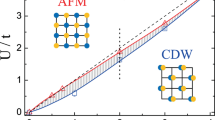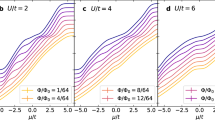Abstract
We investigate the generalized periodic Anderson model describing two groups of strongly correlated (d- and f-) electrons with local hybridization of states and d-electron hopping between lattice sites from the standpoint of the possible appearance of coupled electron pairs in it. The atomic limit of this model admits an exact solution based on the canonical transformation method. The renormalized energy spectrum of the local model is divided into low- and high-energy parts separated by an interval of the order of the Coulomb electron-repulsion energy. The projection of the Hamiltonian on the states in the low-energy part of the spectrum leads to pair-interaction terms appearing for electrons belonging to d- and f-orbitals and to their possible tunneling between these orbitals. In this case, the terms in the Hamiltonian that are due to ion energies and electron hopping are strongly correlated and can be realized only between states that are not twice occupied. The resulting Hamiltonian no longer involves strong couplings, which are suppressed by quantum fluctuations of state hybridization. After linearizing this Hamiltonian in the mean-field approximation, we find the quasiparticle energy spectrum and outline a method for attaining self-consistency of the order parameters of the superconducting phase. For simplicity, we perform all calculations for a symmetric Anderson model in which the energies of twice occupied d- and f-orbitals are assumed to be the same.
Similar content being viewed by others
REFERENCES
P. W. Anderson, Phys. Rev., 124, 41 (1961).
V. A. Moskalenko, P. Entel, M. Marinaro, N. B. Perkins, and C. Holtfort, “Hopping perturbation treatment of the periodic Anderson model around the atomic limit,” Phys. Rev. B (submitted); V. A. Moskalenko and N. B. Perkins, Theor. Math. Phys., 121, 1654 (1999).
M. W. Long, Z. Phys. B, 69, 409, 427 (1988); 71, 23 (1988).
F. Mancini, M. Marinaro, and Y. Nakano, Physica B, 159, 330( 1989).
F. Mancini, M. Marinaro, Y. Nakano, C. Noce, and A. Romano, Nuovo Cimento D, 11, 1709 (1989).
C. Noce and A. Romano, J. Phys. Cond. Matter, 1, 8347 (1989).
C. Noce and A. Romano, Physica B, 160, 304 (1990).
B. R. Alascio, R. Allub, and A. Aligia, J. Phys. C, 13, 2869 (1980).
G. Czycholl, Phys. Rep., 143, 277 (1986).
P. Schlottmann, Phys. Rep., 181, 1 (1989).
S. G. Ovchinnikov, Phys. Usp., 40, 993 (1997).
A. C. Hewson, The Kondo Problem to Heavy Fermions, Cambridge Univ. Press, Cambridge (1993).
P. Fulde, Electron Correlation in Molecules and Solids (Solid State Sciences, Vol. 100, 3rd ed.), Springer, Berlin (1995).
J. Hubbard, Proc. Roy. Soc. A, 27b, 233 (1963); M. I. Vladimir and V. A. Moskalenko, Theor. Math. Phys., 82, 301 (1990).
J. E. Hirsch, Phys. Rev. Lett., 54, 1317 (1985).
V. A. Moskalenko, Sov. Fiz. Metall. Metalloved., 8, 503 (1959).
H. Suhl, B. T. Matthias, and L. R. Walker, Phys. Rev. Lett., 3, 552 (1959).
L. M. Falicov and J. C. Kimball, Phys. Rev. Lett., 22, 997 (1969).
N. N. Bogoliubov, JETP, 7, 41 (1958); Selected Works [in Russian], Naukova Dumka, Kiev (1972).
Author information
Authors and Affiliations
Rights and permissions
About this article
Cite this article
Digor, D.F., Entel, P., Marinaro, M. et al. The Possibility of Forming Coupled Pairs in the Periodic Anderson Model. Theoretical and Mathematical Physics 127, 664–675 (2001). https://doi.org/10.1023/A:1010401720592
Issue Date:
DOI: https://doi.org/10.1023/A:1010401720592




